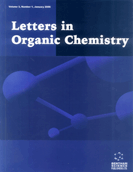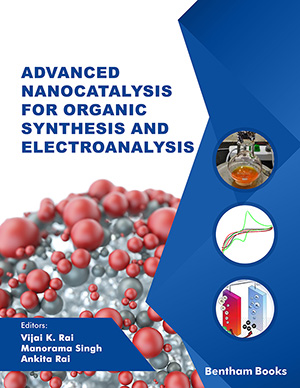Abstract
Complexes of cobalt(II) chloride with 1-propargylimidazole, 1-propargyl-2-methylimidazole, and 1- propargylbenzimidazole ligands were synthesized and studied by FTIR spectroscopy and X-ray analysis. According to the X-ray analysis, the crystal molecules of compounds were connected by non-covalent interactions, such as halogen bonds and π-stacking. The nature and energy of coordination metal-ligand and noncovalent bonds for structures under study were estimated in the frame of QTAIM (Quantum Theory “Atoms In Molecules”). The antimicrobial activity of obtained cobalt(II) chloride complexes was evaluated in relation to microorganisms E. durans, B. subtilis, and E. coli. Complexes of 1-propargyl-2-methylimidazole and 1- propargylbenzimidazole with cobalt(II) chloride demonstrated high activity against E. coli and E. durans relatively and could be recommended as antimicrobial drugs.
Keywords: 1-Propargylimidazole, 1-propargyl-2-methylimidazole, 1-propargyl-2-benzimidazole, complexes of cobalt(II), X-ray analysis, AIM analysis, antimicrobial activity.
[http://dx.doi.org/10.5530/ijper.56.3s.161]
[http://dx.doi.org/10.1039/C6MD00013D]
[http://dx.doi.org/10.14233/ajchem.2021.23099]
[http://dx.doi.org/10.3390/inorganics11020056]
[http://dx.doi.org/10.1016/j.ccr.2021.213930]
[http://dx.doi.org/10.1007/s11172-011-0096-9]
[http://dx.doi.org/10.3390/ijms20092104] [PMID: 31035445]
[http://dx.doi.org/10.1016/j.poly.2019.01.005]
[http://dx.doi.org/10.1134/S001250081612003X]
[http://dx.doi.org/10.1007/978-94-007-7500-8_9] [PMID: 24470095]
[http://dx.doi.org/10.1016/j.jinorgbio.2020.111041] [PMID: 32120161]
[http://dx.doi.org/10.1007/s11224-023-02245-6]
[http://dx.doi.org/10.1016/j.arabjc.2016.04.013]
[http://dx.doi.org/10.1016/S0277-5387(00)00367-3]
[http://dx.doi.org/10.3390/ma14123274] [PMID: 34199318]
[http://dx.doi.org/10.1007/s00706-019-02477-5]
[http://dx.doi.org/10.1007/s11243-019-00328-0]
[http://dx.doi.org/10.1038/s41598-019-46224-6] [PMID: 31278366]
[http://dx.doi.org/10.1016/j.jssc.2022.123111]
[http://dx.doi.org/10.1016/j.partic.2022.03.004]
[http://dx.doi.org/10.1016/j.poly.2022.115741]
[http://dx.doi.org/10.1007/s00216-021-03305-8] [PMID: 33782733]
[http://dx.doi.org/10.1134/S0022476616040338]
[http://dx.doi.org/10.1134/S0022476622080091]
[http://dx.doi.org/10.1016/j.jinorgbio.2009.05.018] [PMID: 19628280]
[http://dx.doi.org/10.1016/j.poly.2012.01.023]
[http://dx.doi.org/10.1107/S1600536805010718]
[http://dx.doi.org/10.1016/j.molstruc.2009.09.036]
[http://dx.doi.org/10.1016/j.jorganchem.2020.121285]
[http://dx.doi.org/10.1107/S0108270199004904] [PMID: 10483705]
[http://dx.doi.org/10.1107/S0108270112020884] [PMID: 22669189]
[http://dx.doi.org/10.1080/00958972.2011.584620]
[http://dx.doi.org/10.3891/acta.chem.scand.26-3995]
[http://dx.doi.org/10.1021/j100785a001]
[http://dx.doi.org/10.1039/b611033a] [PMID: 19810406]
[http://dx.doi.org/10.1002/chem.200700666] [PMID: 17896335]
[http://dx.doi.org/10.1007/s00894-019-4140-2] [PMID: 31338608]
[http://dx.doi.org/10.1021/acs.jpca.8b09778] [PMID: 30407822]
[http://dx.doi.org/10.1093/oso/9780198551683.001.0001]
[http://dx.doi.org/10.1021/jp981794v]
[http://dx.doi.org/10.1007/s10698-012-9153-1]
[http://dx.doi.org/10.1016/j.molstruc.2017.11.030]
[http://dx.doi.org/10.1134/S1070363212070122]
[http://dx.doi.org/10.1016/j.molstruc.2021.129947]
[http://dx.doi.org/10.1016/S0009-2614(98)00036-0]
[http://dx.doi.org/10.1186/s13065-020-00730-1] [PMID: 33602331]
[http://dx.doi.org/10.1007/978-981-16-8399-2_4]
[http://dx.doi.org/10.1007/978-981-16-8399-2_9]
[http://dx.doi.org/10.1107/S0108767307043930]
[http://dx.doi.org/10.1107/S0021889808042726]
[http://dx.doi.org/10.1002/anie.198406271]
[http://dx.doi.org/10.1016/B978-0-12-801238-3.02486-7]
[http://dx.doi.org/10.1038/nprot.2007.521] [PMID: 18274517]



























